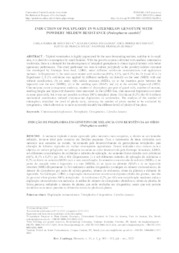Induction of polyploidy in watermelon genotype with powdery mildew resistance (Podosphaera xanthii).
Induction of polyploidy in watermelon genotype with powdery mildew resistance (Podosphaera xanthii).
Autoria: SILVA, C. M. de J.; DIAS, R. de C. S.; SANTOS, J. S. dos; SOUZA, F. de F.; MELO, N. F. de
Resumo: Triploid watermelon is highly appreciated by the most demanding markets, and due to its small size, it is ideal for consumption by small families. With the growth in areas cultivated with seedless watermelon worldwide, there is a demand for the development of tetraploid germplasm to obtain triploid hybrids with better agronomic performance. This study performed two tests to induce polyploidy in the powdery mildew?resistant line developed by Embrapa Semi-Arid, LDRO, under different colchicine concentrations and application methods. In Experiment 1, the seeds were treated with colchicine (0.0%, 0.1%, and 0.2%) for 24 h and 48 h. In Experiment 2, 0.2% colchicine was applied by different methods: (a) directly on the seed (MDS) with and without scarification, (b) on seeds with radicle emission (MER), (c) at the insertion point between the hypocotyl and the root (MIHR), (d) at the seedling apex (MAP), and (e) in the inverted hypocotyl (MHI). Chromosome count (cytogenetic analysis), number of chloroplasts per pair of guard cells, number of stomata, seedling height, and hypocotyl diameter were measured. In the LDRO line, chromosomal duplication occurred in some plant cells, but it was not possible to obtain 100% tetraploid plants. Colchicine (0.2%) for 48 h without mechanical scarification induced chromosomal duplication in watermelon. The analysis of the number of chloroplasts identified the level of ploidy early, reducing the number of plants needed to be evaluated by cytogenetics, which allowed us to more accurately identify the different levels of ploidy of the plant.
Ano de publicação: 2022
Tipo de publicação: Artigo de periódico
Unidade: Embrapa Semiárido
Observações
1 - Por padrão são exibidas publicações dos últimos 20 anos. Para encontrar publicações mais antigas, configure o filtro ano de publicação, colocando o ano a partir do qual você deseja encontrar publicações. O filtro está na coluna da esquerda na busca acima.
2 - Para ler algumas publicações da Embrapa (apenas as que estão em formato ePub), é necessário ter, no celular ou computador, um desses softwares gratuitos. Sistemas Android: Google Play Livros; IOS: iBooks; Windows e Linux: software Calibre.
Acesse outras publicações
Acesse a Base de Dados da Pesquisa Agropecuária (BDPA) para consultar o acervo completo das bibliotecas da Embrapa.

